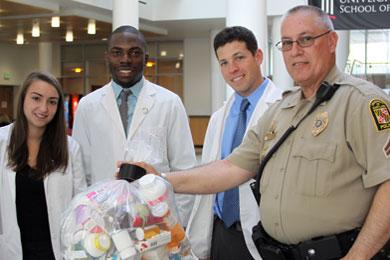MPC Provides Data Tracking for State’s Naloxone Administration Program
Tracking of patients who receive medication for treatment of opioid overdose will lead to better understanding of outcomes
By Becky Ceraul
February 3, 2015
The Maryland Poison Center (MPC) at the University of Maryland School of Pharmacy has partnered with the state’s Department of Health and Mental Hygiene (DHMH) to track the administration of a medication used to treat opioid overdoses. As part of the state’s Overdose Response Program (ORP), the administration of naloxone, a medication that helps reverse an opioid-related overdose, is being reported to the MPC in near real-time for the purposes of surveillance and public health.
Suzanne Doyon, MD, medical director of the MPC, was the lead author on a position statement titled “Expanding Access to Naloxone in the United States,” which was published co-jointly in the Journal of Medical Toxicology and the journal Clinical Toxicology in late 2014. This position statement is the first from national professional organizations to directly support increasing access to naloxone. It supports innovations in drug delivery, cost-containment, and removal of medical and legal barriers that currently restrict access. Finally, the statement encourages the use of the United States’ extensive poison center system to provide advice, augment local training, and assist in collecting data, as done by the MPC for Maryland’s ORP.
Doyon leads the MPC’s naloxone tracking program. “As a member of Maryland’s State Overdose Advisory Council, I was involved in the ‘ORP Bill of 2013,’” says Doyon. “The bill authorizes the DHMH to institute and oversee a program that allows certain trained individuals to administer naloxone to a victim of an opioid overdose.”
Under the ORP, any individual over the age of 18 can receive the training and a prescription for naloxone. The goal of the program is to reduce the number of deaths due to overdoses since the majority of overdoses happen in the community – away from access to immediate medical care.
According to the National Center for Health Statistics, the number of deaths from drug overdoses has tripled in the last three decades with death from a heroin overdose rising by 55 percent between 2000 and 2010. An overdose of an opioid such as heroin, methadone, or prescription pain medication can result in a victim not being able to breathe. Naloxone is a medication that has been used in hospitals and by EMS personnel since 1970 to reverse the effects of an opioid overdose.
“Naloxone is very effective and relatively inexpensive ,” says Doyon. “The benefits of allowing bystanders who are properly trained to administer the medication are unmeasurable. Death occurs minutes after a victim stops breathing, and often occurs before first responders arrive at the scene. Naloxone administered by bystanders early can be life-saving.
Previous studies have shown that the administration of naloxone by bystanders has reversed the effects of an opioid overdose in anywhere from 75 to 100 percent of documented cases.
For its part in the program, the MPC is notified by a bystander, a police officer, EMS, or a hospital emergency department that naloxone was administered. After receiving this information, the MPC engages in a series of follow-up steps to track the victim through the health care system from ambulance ride to emergency department, to hospital admission and finally to discharge. Additionally, the MPC is also capable of answering any question related to naloxone pre- or post-training, all on a 24 hours a day, seven days a week basis.
“This tracking leads to more accurate and consistent documentation,” says Doyon. “It puts to great use the know-how and expertise of the MPC staff and allows for documentation of naloxone’s clinical effects and potential adverse effects in a centralized electronic database. This information has proved extremely valuable to DHMH as it looks to expand the ORP in 2015.”
Any information reported to the MPC about the administration of naloxone is confidential and secure: the MPC protects the confidentiality of all information it receives in accordance with the requirements of the federal Health Insurance Portability and Accountability Act (HIPAA) and the Maryland Confidentiality of Medical Records Act.
“This project is a terrific example of collaboration between the MPC and DHMH,” says Doyon. “This unique collaboration serves as a model to other states with naloxone administration programs and has the potential to benefit all Marylanders.”



